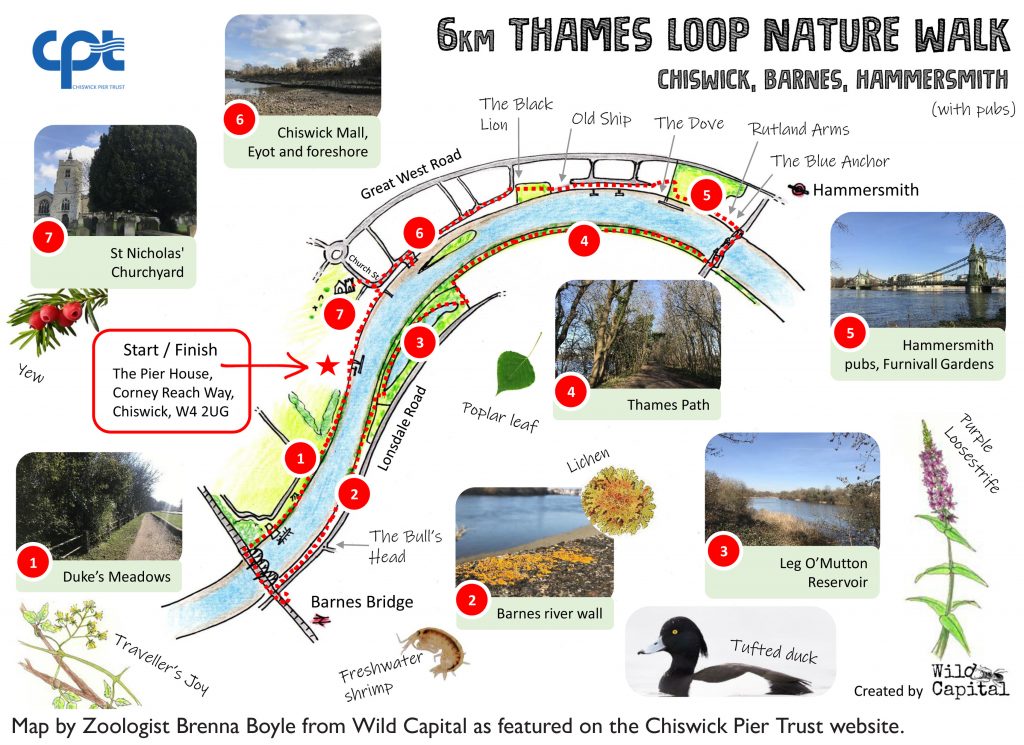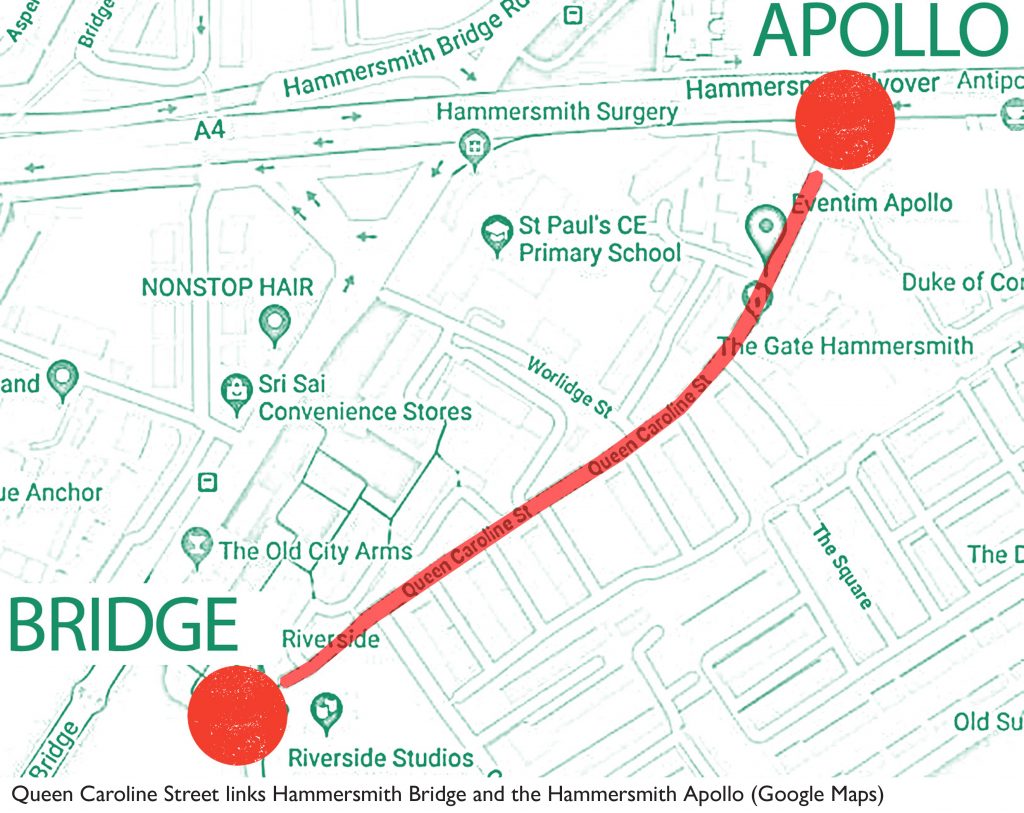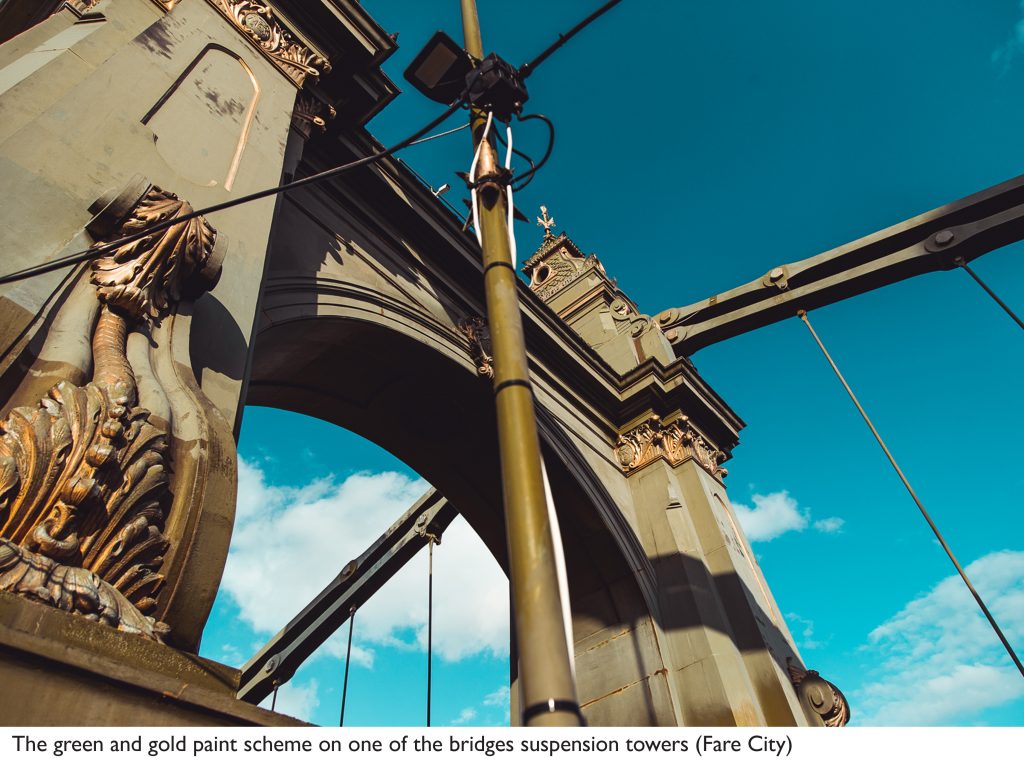
Hammersmith Bridge will be closed to motorised vehicles for up to three years because of structural faults. Fare City believes that this is a great opportunity for bridge users to understand a bit more about this impressive structure, and why it is such an important local asset. Here we have assembled a range of facts, recommendations, survey findings and trivia aimed at helping the public to gain some real value from the bridge during this part closure. Enjoy!
A // Active Travel
Active travel means making journeys by physically active means. There are certainly more people walking and cycling since the bridge’s closure to motorised vehicles, as confirmed by our Hammersmith Bridge survey. The current surface repairs to the pedestrian walkways should help to further improve the experience of crossing the bridge on foot.
B // Benches
Grab a seat on one of Hammersmith Bridge’s wooden benches. The benches are unique in being the only seats in London which provide you with an unobstructed view of the Thames (as you sit above it). We find this fascinating if you consider that collectively London’s bridges stretch for a total of approximately 5.2 km!

C // Car Free
Keeping Hammersmith Bridge car free once re-opened was the preferred choice (among those aged 29 and under) in our survey. Doing so will put less strain on the bridge and may persuade regular car users to switch to more sustainable modes of transport, which in turn may ease congestion.
D // Design
The bridge’s designer, Sir Joseph Bazalgette, modified one London bridge (Albert Bridge 1884), and designed a further three: Putney Bridge (1886), Hammersmith Bridge (1887), and Battersea Bridge (1890). Both the Albert Bridge and Hammersmith Bridge are suspension style bridges and have undergone further strengthening, as they are unable to meet the demands of modern traffic. In contrast, those at Putney and Battersea are five-span granite bridges which are well equipped to handle modern traffic. Interesting, given the mere six years between the works.
E // Experience
For the best experience of walking across the bridge try the west walkway (situated to the left of the carriageway as you approach Hammersmith). It’s generally less busy than the east walkway, especially during rush hour, while it also allows you to soak up some sublime sunsets. Enjoy!
F // Fractures
Hairline micro fractures in the bridge’s cast iron pedestals were discovered in the spring of 2019, and they are the reason for the bridge’s current partial closure. Engineers have stated that vibrations from motorised vehicles could widen these fractures, which is why traffic enforcement wardens are currently posted at either end of the bridge.
G // Green Bridge
The bridge’s distinctive green and gold colour scheme was reinstated in 2000, in accordance with bridge designer Sir Joseph Bazalgette’s original choice. Is it just a coincidence that London’s original green bridge acts as a gateway to Richmond upon Thames, London’s greenest borough?
H // Heritage Asset
The bridge is a designated Grade II* listed structure (a listing applied to ‘particularly important buildings of more than special interest’). The Historic England designation specifically states that the bridge’s architectural quality makes it ‘one of the most distinctive on the Thames’. In spite of this, it is in desperate need of repair to enable it to be enjoyed by both current and future generations.
I // Icon
The bridge is truly iconic. This is because William Tierney Clarke’s original 1827 Hammersmith Bridge (the stone piers of which support the current bridge) was in fact one of the world’s first suspension bridges. The current Hammersmith Bridge was designed by the celebrated engineer Sir Joseph Bazalgette, and is just one of the reasons why Historic England upgraded its designation from Grade II to Grade II* listed in 2008.
J // Jogging
Hammersmith Bridge is very popular with joggers, who cross it as part of a longer run. The bridge itself is 250.5 meters long, meaning that crossing it in a loop along both footpaths 85 times (or 170 crossings back and forth) would add up to the distance of a marathon! Perhaps best not to try this, but fascinating nonetheless.
K // Kilometers
Six kilometers is the length of the Chiswick Pier Nature Walk. The walk consists of a loop starting and ending at Pierhouse in Chiswick. It takes in the sights and sounds of Dukes Meadows, the Lonsdale Road Reservoir and of course, Hammersmith Bridge. The beautifully illustrated map and guide will help you to enjoy this stretch of the Thames all year round. Why not give it a go!

L // Longevity
The bridge is a survivor. The current bridge was opened in 1887 and has since endured 3 failed bomb plots (1939, 1996 and 2000), as well as lengthy closures owing to structural weakness. However, if the bridge is to be enjoyed by future generations it must be repaired in a way that does not invite further structural damage or alter its special character.
M // Market
The majority of those surveyed believed that they could see some benefit for the use of the bridge as a community market, one day a month. This figure was even higher among those aged 29 years and under. The bridge is a valuable heritage asset and could provide a new and unique public space, bring people together and potentially unlock a new revenue stream for the local economy.
N // Noise
The levels of noise on the bridge have dropped dramatically since its closure to motorised vehicles. The distinctive rumbling of cars and buses going over was due to the timber deck surface, which was bolted over with plywood panels and sealed with asphalt. A number of respondents in our survey suggested that excessive noise and vibrations from vehicles used to make them feel nervous when crossing on foot.
O // Opportunity
Hammersmith and Fulham Council have confirmed that the bridge will be closed to motorised vehicles for up to three years. In this period there is a chance to enjoy some of the benefits of this partial closure, including improved air quality, less noise and the opportunity to make positive lifestyle changes, including walking and cycling more often.
P // Pollution
Help to tackle pollution at Hammersmith Bridge by volunteering to clear litter at low tides. Rivers are natural habitats which are becoming increasingly threatened by single use plastic. Fortunately, London based charity Thames21 schedules regular clean ups which are open to people of all ages and abilities. Click here to find out more.
Q // Queen Caroline Street
This residential street is unique in linking two West London icons: Hammersmith Bridge and The Hammersmith Apollo. Both the bridge and the theatre are Grade II* star listed, the former a triumph of Victorian engineering, while the latter is a revered 1930’s art deco venue. A seven-minute walk along Queen Caroline Street connects the two and provides a distinct contrast between the open riverside and the crowded gyratory.

R // Rickshaw
A rickshaw service operated by shared transport provider Ginger offers an alternate way of travelling between Castelnau, on the bridge’s south side, and The Hammersmith Apollo. This service charges a flat fare of £2 per person and operates between 0730 – 1900 on weekdays. If you haven’t done so already – give it a go!
S // Safety
Many cyclists have said that they feel safer since the bridge’s closure to motorised vehicles, as more space means that potholes can be easily avoided. However, Hammersmith and Fulham Council desperately need to provide better lighting for pedestrians crossing the bridge at night, especially with the onset of winter, which means fewer daylight hours.
T // Thames
The immediacy of the river can be striking, owing to Hammersmith Bridge having the lowest clearance of all London’s bridges, just twelve feet at high tide. Look on as rowers relentlessly traverse this stretch of water, or marvel as herons methodically pick their way through the mud flats at low tide.
U // University Boat Race
The bridge is located at the halfway point of the famous Oxford and Cambridge boat race. Considered one of the race’s best vantage points, it is where the advantage of the fabled Surrey Bend comes into play for the crew nearest the south bank. Position yourself at the second lamp post away from the south bank’s suspension tower (looking back towards Putney), and the boats should pass directly underneath you!
V // View
Hammersmith Bridge is recognized as being one of London’s most distinctive and photogenic bridges. For panoramas of the bridge from the north bank head to the Capability Brown Statue on the Thames
Path, or to Furnival Gardens further west. For a more intimate view of the bridge try the Thames Path immediately off Castelnau on the south bank, or better still, explore the bridge itself.

W // Weight Limit
Hammersmith Bridge is London’s weakest vehicular bridge, with a weight limit of just 7.5 tonnes. The consensus held by all the major city authorities is that the bridge ‘simply wasn’t designed for modern traffic’, which begs the question: why are these same authorities insisting that the bridge fulfills this role?
X // X marks the spot
At the halfway point on the west walkway several plaques are fixed to the handrail. One of these marks the spot where Charles Campbell Wood, a South African RAF serviceman, dived into the Thames to save a woman who had fallen over the side of the bridge. Wood saved the woman’s life but tragically died himself a few weeks later, having contracted tetanus from a cut sustained during the incident.
Y // Young People
Recent research suggests that young people are driving less than people born a generation ago. Many Millennials and Gen-Z (collectively those aged under 40), forgo gaining a driving license, whilst a large percentage of those that do drive are favoring rental options over car ownership. While this is due to many reasons, our survey showed that a lot of young people are coming to identify combustion vehicles with climate change.
Z // Zero Emissions
The current closure of the bridge to motorised vehicles has drastically reduced combustion vehicle emissions in the vicinity of the bridge. Our survey confirms that bridge users believe that the single biggest benefit of this partial closure is an improvement in air quality.










